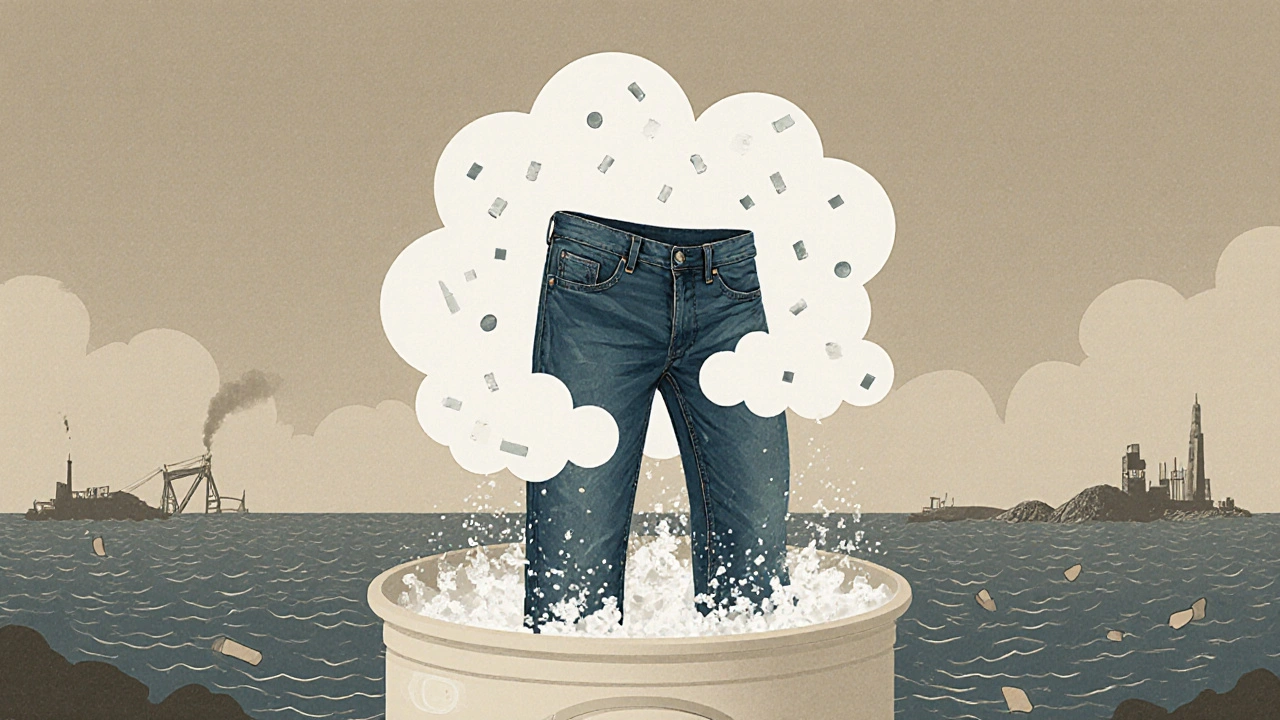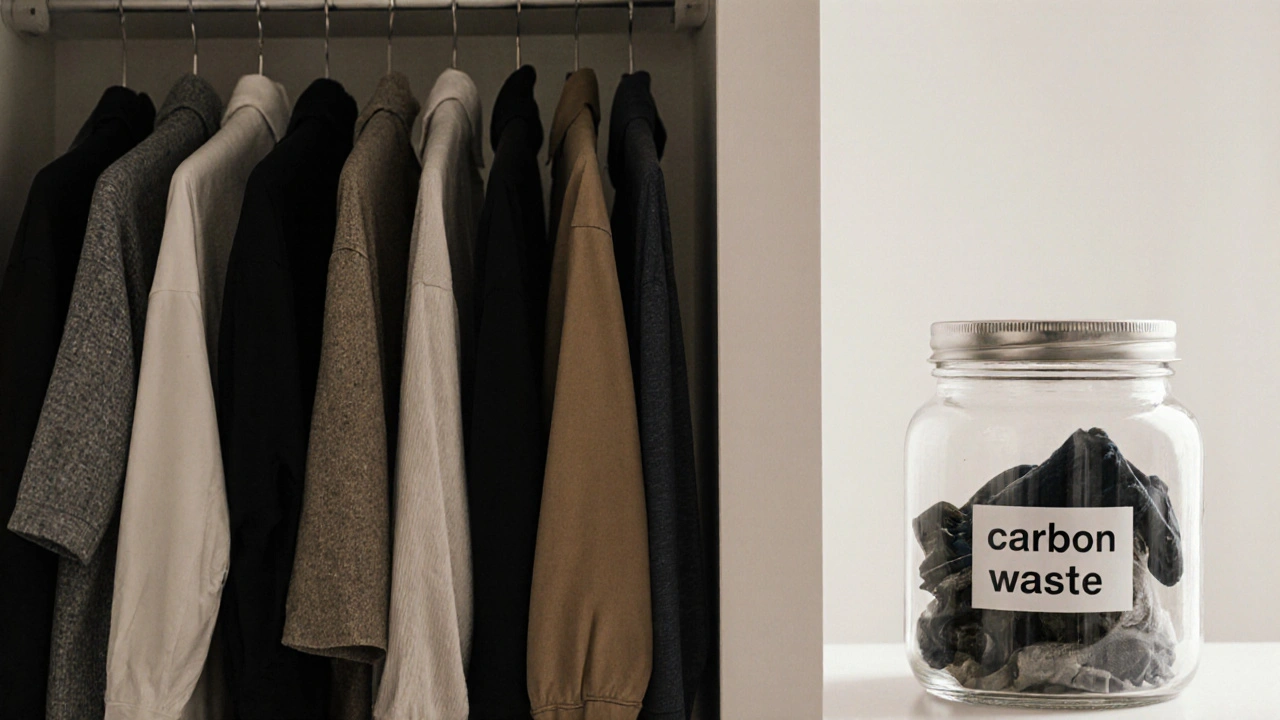Every time you buy a new shirt, pair of jeans, or pair of sneakers, you’re not just spending money-you’re adding to a hidden environmental cost. The fashion industry produces 10% of global carbon emissions, more than all international flights and maritime shipping combined. And most of it comes from the clothes we already own, not just the ones we buy. A wardrobe carbon audit isn’t about guilt-it’s about clarity. It’s the simple process of figuring out what’s actually in your closet, how much it’s costing the planet, and where you can make real changes without throwing anything away.
What a Wardrobe Carbon Audit Actually Means
A wardrobe carbon audit tracks the greenhouse gas emissions tied to every item in your closet, from cotton farming to landfill decay. It’s not about counting how many clothes you have. It’s about understanding the hidden impact behind each tag. A single cotton T-shirt can use 2,700 liters of water and emit 2.1 kg of CO₂. A pair of synthetic jeans might release 33 kg of CO₂ over its lifetime-mostly from washing and drying. These numbers aren’t theoretical. They come from studies by the Ellen MacArthur Foundation and the United Nations Environment Programme.You don’t need a lab to run this audit. You just need to look at your clothes, ask a few questions, and track what you already know. Start by pulling everything out. Lay it all on the floor. Now, group them by material: cotton, polyester, wool, linen, blends. These materials have wildly different footprints.
How to Calculate Your Closet’s Footprint
Here’s a simple system anyone can use, no app needed:- Sort by material. Cotton and linen are lower-impact if organic. Polyester and nylon are plastic-based and release microplastics every wash. Wool and silk have high water and land use.
- Estimate frequency of use. How many times have you worn each item in the last year? A shirt worn 50+ times has a much lower per-wear footprint than one worn twice.
- Track care habits. Washing in cold water, air-drying, and skipping the dryer cuts emissions by up to 70%. If you dry everything on high heat, you’re doubling your impact.
- Flag items you never wear. Clothes sitting untouched for over a year? They’re carbon waste. They cost the planet to make, transport, and store-and you never used them.
Use this rough estimate: Every new garment you wear fewer than 10 times adds more than 20 kg of CO₂ to your footprint. That’s like driving 50 miles in a car. If you’ve bought 20 new clothes this year and only wore half of them more than five times, you’ve added 200 kg of CO₂-equivalent to leaving a 60-watt bulb on for a year.
Top 5 High-Impact Items in Most Closets
You don’t need to audit every sock. Focus on these five troublemakers:- Fast fashion jeans. Made with conventional cotton, shipped overseas, washed 20+ times, then tossed. Average footprint: 33 kg CO₂.
- Synthetic activewear. Polyester leggings release 700,000 microplastics per wash. Most are worn once or twice and never recycled.
- Leather shoes. Cattle farming drives deforestation. A single pair can emit 20-30 kg CO₂, not counting transport.
- Blended fabrics. Cotton-polyester mixes can’t be recycled. They end up in landfills and break down into toxic sludge.
- Seasonal trend pieces. That neon jacket from last spring? It was made for one season. Most are never worn again.
These five categories make up 60-70% of the carbon footprint in the average American wardrobe. Fix these, and you fix most of the problem.

How to Reduce Your Closet’s Footprint-Without Buying New
You don’t need to go full minimalist. You just need to make smarter choices with what you already have.- Wash less, wash cold. Only wash clothes after 3-5 wears, unless they’re sweaty or stained. Cold water cuts energy use by 90%.
- Air-dry everything. Skip the dryer. Even on a cloudy day, clothes dry in 4-6 hours indoors. A dryer uses as much energy as a refrigerator in a month.
- Repair, don’t replace. A $10 sewing kit fixes 80% of torn seams, broken zippers, and loose buttons. Local tailors often charge under $15 to fix jeans or jackets.
- Swap, don’t shop. Host a clothing swap with friends. One event can give 30+ items new life. No money changes hands. Just clean clothes, good vibes.
- Donate with purpose. Don’t just drop bags at thrift stores. Use platforms like thredUP or The RealReal for resale. If it’s not sellable, find a textile recycler-many cities now have drop-off bins for old fabrics.
One woman in Brooklyn reduced her wardrobe’s carbon footprint by 42% in six months by doing just these five things. She didn’t buy a single new item. She just stopped wasting what she had.
What to Buy Next-If You Must Buy
If you need something new, here’s how to pick low-impact options:- Choose natural, unblended fibers. Organic cotton, hemp, TENCEL™, linen, and wool (from certified farms) are better. Avoid blends.
- Look for durability. Check stitching, fabric weight, and brand reputation. A $120 pair of jeans that lasts 10 years beats five $30 pairs that die in 6 months.
- Support brands with transparency. If a company won’t tell you where their cotton is grown or how their dye is treated, walk away. Brands like Pact, Thought Clothing, and Eileen Fisher publish full supply chain reports.
- Buy secondhand first. ThredUP, Poshmark, and local consignment shops have high-quality items at 60-80% off. A $50 coat from 2020 has a near-zero footprint.
- Ask: Will I wear this 30 times?. If the answer isn’t yes, don’t buy it. That’s the 30-wear rule. It’s simple. It works.

What Happens When You Don’t Audit Your Wardrobe
Most people think they’re doing fine because they don’t shop often. But the real problem isn’t buying-it’s holding on to things that don’t serve you. The average American throws away 81 pounds of clothing every year. Less than 15% gets recycled. The rest rots in landfills, releasing methane, a greenhouse gas 25 times worse than CO₂.And here’s the kicker: the more clutter you have, the more you buy. Studies from Stanford show that people with overflowing closets buy 30% more new clothes because they can’t see what they own. It’s not about style-it’s about cognitive overload. A clear closet means fewer impulse buys, less waste, and less guilt.
Your 30-Day Wardrobe Reset Plan
Here’s a real, doable plan to cut your fashion footprint fast:- Week 1: Empty and Sort. Take everything out. Group by material. Take photos of items you never wear.
- Week 2: Clean and Repair. Wash everything in cold water. Fix broken zippers, sew loose buttons. Air-dry everything.
- Week 3: Declutter. Donate, sell, or recycle what you don’t wear. Keep only what you love and use.
- Week 4: Reset Habits. Set a rule: for every new item you bring in, one goes out. Start washing less. Start air-drying. Stick to the 30-wear rule.
After 30 days, you’ll have a smaller, cleaner, lower-impact wardrobe. And you’ll feel lighter-not just physically, but mentally. You’ll stop seeing clothes as disposable and start seeing them as resources.
Final Thought: Your Closet Is a Microcosm of the System
Your wardrobe isn’t just about fashion. It’s a mirror of how we treat resources, labor, and time. Every time you choose to repair, reuse, or refuse, you’re voting against fast fashion’s broken model. You’re not saving the planet by yourself-but you’re showing others it’s possible. And that’s how change starts.What’s the average carbon footprint of a wardrobe?
The average American wardrobe emits about 1,000 kg of CO₂ per year-equivalent to driving a car 2,500 miles. About 70% of that comes from washing, drying, and discarding clothes, not making them. The rest comes from production and transport.
Is buying secondhand really better for the environment?
Yes. Buying a used cotton t-shirt instead of a new one saves about 2,000 liters of water and cuts CO₂ emissions by 75%. Even synthetic items reused from thrift stores avoid the emissions from new plastic production. Secondhand is the lowest-impact way to refresh your wardrobe.
Do eco-friendly fabrics really make a difference?
Yes, but only if they’re used properly. Organic cotton uses 91% less water than conventional cotton. TENCEL™ is made from sustainably harvested wood pulp and uses a closed-loop process that recycles 99% of its solvents. But if you wash them in hot water and dry them in the dryer, you erase most of the benefit. Material matters-but how you care for it matters more.
Can I recycle old clothes in my city?
Many U.S. cities now have textile recycling bins-look for Blue Jeans Go Green, H&M’s garment collection, or local drop-offs through TerraCycle. Even stained, torn, or missing socks can be turned into insulation or industrial rags. Don’t throw them in the trash. Textile recycling is free and widely available in New York, Chicago, LA, and most major cities.
How often should I do a wardrobe audit?
Do one seasonal audit-spring and fall. That’s when you naturally switch clothes and notice what’s gathering dust. A quick 15-minute check every three months keeps you aware of your habits. The goal isn’t perfection-it’s awareness.


Write a comment